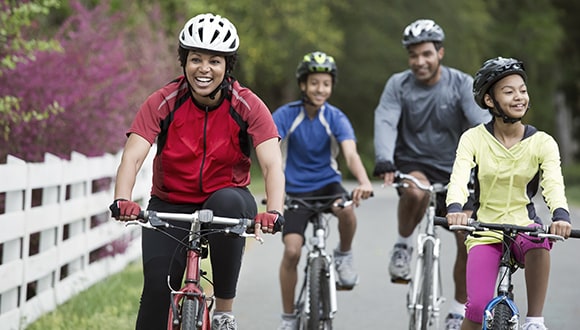Family Fitness Activities: How to work out with your kids (and enjoy it)
If you struggle to find time for your own exercise due to family commitments, here are some family fitness activities for working out with your kids.
70% of children aged between 2 to 17, and 55% of adults don’t meet the government’s physical activity recommendations, reports The Department of Health. An Ausplay study also found that while 3 in 4 adults stayed active in 2020, only 1 in 6 kids exercised outside of school.
Coming together as a family to be physically active may not only increase fitness, it could also build stronger relationships.
How to be an exercise role model to your kids
Family fitness begins with parents, says personal trainer Lauren Hannaford, who works with children and parents to encourage regular physical activity. “Doing physical family activities is good for your health, but also for the emotional health of the whole family,” she says.
When we’re busy, fitness as a family can easily be the last thing on our list of priorities, but there are ways to incorporate it into our lives with fun family activities.
“Parents can influence their children’s attitude to exercise by showing them how to be active themselves, such as encouraging kids to join in their own workout, walk or jog,” says Lauren. Physically active children are more likely to continue to be active as they get older.
UK research published in the American journal Pediatrics found that if mothers were active, their preschool-aged children were likely to engage in more activity. For example, if a mother spent 1 hour being active a day, her child was more likely to spend an extra 10 minutes being active a day.
The researchers say: “Such small minute-by-minute differences may represent a non-trivial amount of activity over the course of a week, month and year. This is likely to have long-term health benefits for both.”
Although the study only researched mothers, it’s likely that fathers or any primary caregivers can have the same impact.
The long-term health benefits may include a lower risk of heart disease and heart attacks, improved outcomes for weight management, a reduced risk of type 2 diabetes and high blood pressure and overall, a healthier frame of mind.

Make family fitness and activities a priority
For family fitness to occur regularly, Hannaford suggests you include it in the time you spend together doing family activities. And you don’t have to spend large amounts of money, either.
For example, heading outdoors for a picnic in the park can involve a soccer game, a game of tag or cricket, tree climbing or a hike. A visit to the beach can involve a swim, frisbee or even sprints in the sand.
It’s important to get creative, says fitness trainer Ali Cavill, who runs family activity boot camps. “Encouraging children to lead a healthy lifestyle is most effective if the focus isn’t on a specific exercise, but about having fun,” she says.
Get involved with kids’ sports team or activities
If you’re pushed for time outside of your children’s activities, why not volunteer as a coach or support staff for your children’s sports team or activity? “Since you have to take your child to the sport anyway, volunteering at Nippers, football or netball is a good step towards role-modelling,” says Ali.
What are the benefits? “You’ll be spending time with your child on a sport they’re involved in,” she says. “Your children will also be more likely to talk to you about anything that’s bothering them, when you’re working so closely together as a team.”
This is especially important if you have teenagers. “During the teenage years, sport involvement tends to drop off, so by volunteering at their sport, you’re with them at least twice a week and encouraging them, too.”
Top tips for improving your family fitness routines
- Train together
If your child plays football or netball, why not train together during the week?
- Think differently
Creating a family garden bed can bring you joy. Bushwalking, mountain bike riding or discovering natural waterholes for swimming are other great ways to spend time together for family activities.
- Set a family goal
“Sign up for a fun run or marathon,” says Lauren. “You’ll be working towards a common goal and could even raise money for charity.”
- Make it monthly
It may be difficult to fit in regular family activities doing sport but try to do what you can. Find the time for a monthly family activity such as shooting hoops at an outdoor basketball court.
Words by Charmaine Yabsley
Updated October 2021
Related articles
IS IT HARDER TO LOSE WEIGHT WHEN YOU’RE OLDER?
With a few lifestyle changes, maintaining a healthy weight doesn’t have to be hard as you age.
HOW ‘GREEN SPACE’ CAN IMPROVE YOUR HEALTH
Walking in the park, swimming and chasing waterfalls can all boost your overall health.
HOW TO CARE FOR YOUR TEEN’S MENTAL HEALTH
Recognising emotional issues early is the best way to protect your teenager against depression and anxiety.